There are three salt lakes in the Valley. That’s where the latest road trip saw freelance travel writer and fellow Texas Master Naturalist Eileen Mattei and me.
We ventured to the closest one very early one morning — the one with the shortest hike from the parking lot — La Sal del Rey, 18 miles north of Edinburgh.
Eileen has talked about these lakes since I’ve known her. She’s visited and written about them several times. As soon as she would mention it’s quite a hike from the parking lot to the lake, I’d lose interest. That, and she generally made the trek in the winter when the weather didn’t seem to be at its best — but the birding is.
Still, I didn’t realize La Sal del Rey was in the Valley, always imagining it somewhere up north, like north of Texas even, which didn’t interest me.
On a lovely summer day in deep July, Eileen’s on assignment and needing a photographer; an early morning start on a trip to a lake didn’t seem all that dreadful.
At the lake, a sweet little car park just off the road is the first impression. It’s enclosed by towering trees, shady, peaceful and inviting, We sprayed down with bug spray, checked we had water, hats, notebook, pens and cameras.
Exciting new vegetation was all around me. Our first discovery was Rose Palafoxia, Palafoxia rosea, in the aster family. It’s like a carnation spiked with hair gel and peppered with, well, peppered with pepper. We oohed and ahhhhed.
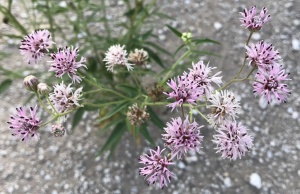
Finally through the gate and onto the trail, the usual suspects greeted us: mesquite, huisache, coyotillo, brasil, black brush, ebony. The hike in didn’t seem to take long because of all the vegetative scenery and other fun stuff on the mostly level, well-maintained caliche trail.

I saw my first Texas dung beetles. Interestingly — and conveniently — the animals deposit their “droppings” on trails so we humans don’t have to go searching for scat to guess which critters might be watching us.
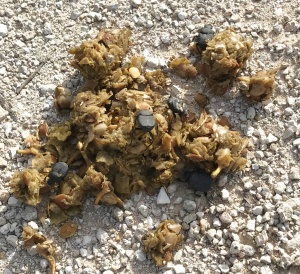
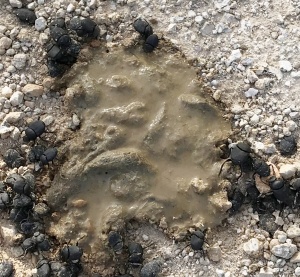
There were an amazing number of dung beetles.
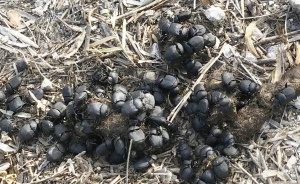
As I’ve mentioned, we’d left town early which put us to the site about 9 a.m. Still, it was the end of July. Although a pleasant stroll to the lake site, the hotter the day became and the heavier the humidity, the longer that one-half-mile hike seemed.
I can get a bit whiny sometimes, but recall only asking three time, “Are we there yet?” to which Eileen would point to an elusive bend in the trail – “Just there,” she’d say brightly. She’s such a good cheer leader.
The lake and the surrounding Tamaulipan thornscrub and grasslands are part of the U.S. Fish and Wildlife Service’s Lower Rio Grande Valley National Wildlife Refuge. It’s rather fascinating to know the lake is sitting atop about four million tons of salt — check out more about the lake here:
https://www.fws.gov/refuge/Lower_Rio_Grande_Valley/visit/la_sal_del_rey.html
Once we finally rounded that illusive bend, we saw the lake — and a pretty deep shore line — surrounded by Tamaulipan thornscrub and drifts of salt like a dusting of snow.
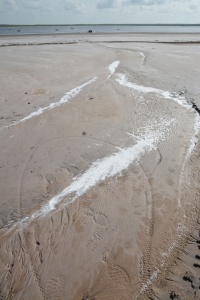
As we hoofed it carefully across the slick mud toward the water, we began seeing a multitude of tracks: bicycle, tennis shoe, bird, critter — and one really impressively huge mountain lion track! It was far too big to be a bobcat — we were sure.
I couldn’t find my Nature Tracker six-inch ruler, a freebie from the Texas Parks and Wildlife Department’s iNaturalist training from March, but came up with a quarter coin to measure perspective; the quarter was absolutely dwarfed by the huge print left in the mud.
I’m sure you’ll agree, we were following the fresh path of a mountain lion.
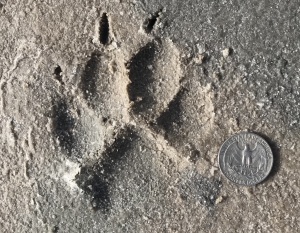
We were awfully excited about our find. We looked over our shoulders and scanned the forest edge to make sure the big cat wasn’t near. We were so excited we texted two friends who would know these things. “Young puma, but could be a big bobcat — really big bobcat,” came one answer; “Mountain lion – rare here, but they’ve been seen,” was another.
Amazingly, iNaturalist said we were way off. In fact, not feline at all, but canine. And domestic canine at that, although discussion ensued within the Website. Now it’s up between a (big) coyote or (again, big) domestic canine.
The mud flat was rife with tracks and scat; the quarter really got a work out — the muddy shore is a popular route between thorn forests.
The deeper nilgai tracks were filled with a nice crunchy layer of salt.
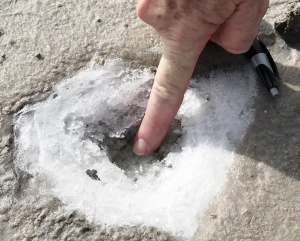
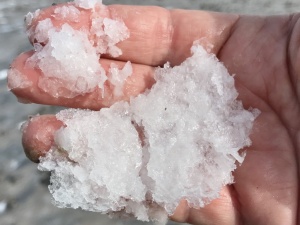
Not only tracks get salted in; scat gets dried and salted as well.
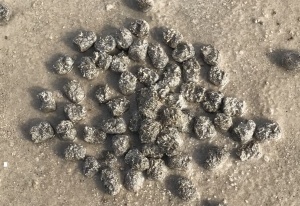
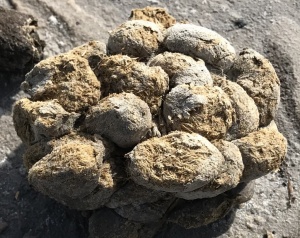
More tracks we could only guess at.

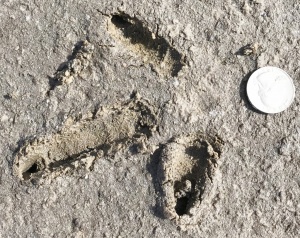
The riparian edge itself is lined with colorful, tiny succulent-like plants in pinks, greens, golds and lavenders.
Possibly Sea Blite, Suaeda linearis, or Glasswort, Salicornia virginica or S bigelovii, in the Chenopodiaceae family — Thank you Island Linda artist-extraordinaire-McGonigle for cluing me into the possible family name and sea blite species.
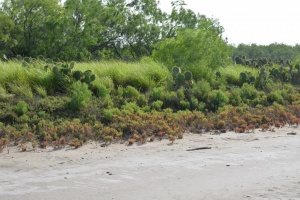
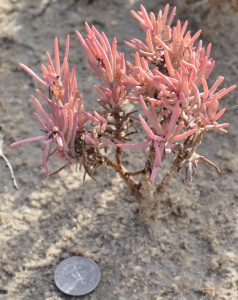

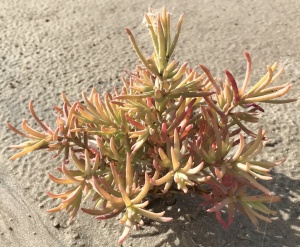
After two hours, we dragged our hot bodies back, dripping with sweat — equally out of water and conversation by the time we made it back to the car. Another grand excursion. Still, we agreed, a deep-summer hike isn’t for sissies.
If you’d like to learn more about scat, Resaca de la Palma is having three scat events — Sunday, August 12, then Sundays in September, the 2nd and 23rd.
Between 10 and 11 a.m. all three days, you can walk around with a ranger, looking for what animals might have left traces of their last meal . . . .
For more information, call the park at 956-350-2920.